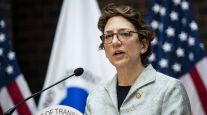Staff Reporter
NHTSA Forecasts Slight Increase in Truck Crash Fatalities for 2019

[Stay on top of transportation news: Get TTNews in your inbox.]
Fatalities in crashes involving at least one large truck are projected to have increased by 1% in 2019, while overall traffic fatalities are projected to see a decline, according to National Highway Traffic Safety Administration estimates.
NHTSA on May 5 released preliminary figures for the Fatality Analysis Reporting System data for 2019. FARS provides to Congress and the public annual data regarding fatal injuries in motor-vehicle traffic crashes.
FARS accounts for any large truck (gross vehicle weight ratings of greater than 10,000 pounds) on a public highway involved in crashes, including large pickup trucks. While the data do not distinguish between commercial and privately owned trucks, Federal Motor Carrier Safety Administration spokesman Kyle Bonini noted that efforts to improve safety in the commercial sector are important.
Early estimates of 2019 motor vehicle traffic data show reduced fatalities for third consecutive year https://t.co/PVdKQ8VM1P — nhtsagov (@NHTSAgov) May 5, 2020
“FMCSA’s top priority remains to reduce crashes and fatalities on the nation’s roadways,” Bonini said. “That’s why the agency continues to implement important safety initiatives, like a final rule updating the hours-of-service regulations, important research into new assisted technologies for drivers to improve safety and the implementation of FMCSA’s Drug & Alcohol Clearinghouse.”
Despite the projected slight increase in fatalities associated with large-truck crashes, NHTSA’s estimates indicate a decline in overall traffic fatalities. This trend would build on the decline reflected between 2017 and 2018. NHTSA’s projection of traffic fatalities for 2019 shows that an estimated 36,120 people died in motor vehicle crashes, an estimated decrease of 1.2% (or 440 deaths) from the 36,560 fatalities reported in 2018.
“Safety is our top priority, so this report that traffic fatalities appear to have decreased again for the third year is great news,” said Transportation Secretary Elaine Chao.
Early Estimates of 2019 Motor Vehicle Traffic Data Show Reduced Fatalities for Third Consecutive Year https://t.co/YKdeqbnj8f — TransportationGov (@USDOT) May 5, 2020
While traffic fatalities are trending downward, vehicle miles traveled are projected to have increased slightly less than 1%, which translates to about 28.8 billion miles. The projected fatality rate for 2019 was 1.1 fatalities per 100 million vehicle miles traveled, down from 1.13 fatalities per 100 million vehicle miles traveled in 2018. If these estimates are in the finalized data, the fatality rate per 100 million vehicle miles traveled would be the second lowest since NHTSA started recording fatal crash data.
The data also indicate only one of NHTSA’s 10 geographic regions — the southeast region, encompassing Tennessee, Alabama, Georgia, South Carolina and Florida — is estimated to have an increase in traffic-related fatalities, of 2%, in 2019.
“Providing effective behavioral safety programs is one of NHTSA’s top safety missions,” said NHTSA Deputy Administrator James Owens. “We know that without the unyielding efforts from our determined and passionate safety partners at the state and local levels, we could never achieve the projected drop in traffic-related fatalities that have been announced today.”
The fatality counts for 2018 and 2019, and the percentage change between those years, are subject to revision as NHTSA officials finalize the data, which will be available this fall.
“It is too soon to speculate on the contributing factors or potential implications of any changes in deaths on our roadways,” NHTSA’s statistical summary states.
Commercial Vehicle Safety Alliance Director of Crash and Data Programs Christopher Turner noted that, while traffic-related fatalities appear to have gone down slightly from 2018, levels are still higher than they were a decade ago. In 2009, NHTSA reported 33,883 traffic-related fatalities.
Early Estimate of Motor Veh... by Transport Topics on Scribd
Turner, a former captain with the Kansas Highway Patrol, said impaired driving, increased speed limits and distracted driving have contributed to this increase.
Turner recommended enhanced training for drug recognition at the carrier and law enforcement levels for the commercial sector.
He also suggested that in-car devices such as Breathalyzers and Bluetooth chips can restrict a driver’s use of a phone. “Those two measures would be incredibly effective,” Turner said. “We need the willingness of the public to say ‘This is how we save lives.’ ”
In February, NHTSA issued $562 million in grants to 50 states, territories, the District of Columbia and the Department of the Interior’s Bureau of Indian Affairs in an effort to support traffic safety programs.
Want more news? Listen to today's daily briefing:




